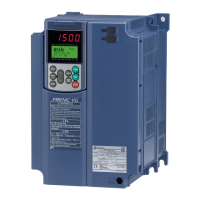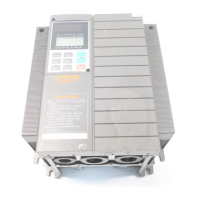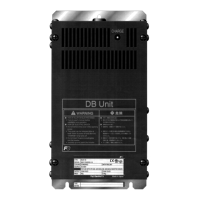5.3 Description of Function Codes
5-233
FUNCTION CODES
Chap 5
d21, d22
d23
Speed agreement/PG error (Hysteresis width and detection timer)
PG error processing
These function codes specify the detection levels of the speed agreement signal “DSAG” and PG error detected
signal “PG-ERR”.
Speed agreement signal
(E20 , E21 and E27, data = 71)
■ Speed agreement/PG error (Hysteresis width (d21) and detection timer (d22))
• Data setting range: (d21) 0.0 to 50.0 (%), in (%) of the maximum speed
(d22) 0.00 to 10.00 (s)
If the speed regulator’s deviation (between the reference speed and detected one) is within the specified range
(d21), the signal “DSAG” turns ON. If the deviation is out of the specified range (d21) for the specified period (d22),
the signal turns OFF. This signal allows the user to check whether the speed regulator works properly or not.
PG error detected signal PG-ERR (E20 to E21 and E27, data = 76)
■
Speed agreement/PG error (Hysteresis width (d21), Detection timer (d22) and PG error processing
(d23))
• Data setting range: (d21) 0.0 to 50.0 (%), in (%) of the maximum speed
(d22) 0.00 to 10.00 (s)
(d23) 0 to 5
If the speed regulator’s deviation (between the reference speed and detected one) is out of the specified range
(d21) for the period specified by d22, the inverter judges it as a PG error.
d23 defines the detection condition (and exception), processing after error detection, and hysteresis width as listed
below.
d23 Function
Detection condition
(and exception)
Processing after error
detection
Hysteresis width for error
detection
0 Continue to run 1 When the inverter cannot
follow the reference speed
(even after soft-starting)
due to a heavy overload or
similar, so that the detected
speed is less than the
reference speed, the
inverter does not interpret
this situation as a PG error.
The inverter outputs the
PG error detected signal
“PG-ERR”
run.
Hysteresis width = d21,
which is constant, even if
the speed command is
above the base frequency
(F04).
1 Stop running with
alarm 1
The inverter initiates a
motor coast to stop, with
the
ere
alarm.
It also outputs the PG error
detected signal “PG-ERR”.
2 Stop running with
alarm 2
No exception.
3 Continue to run 2 When the inverter cannot
follow the reference speed
(even after soft-starting)
due to a heavy overload or
similar, so that the detected
speed is less than the
reference speed, the
inverter does not interpret
this situation as a PG error.
The inverter outputs the
PG error detected signal
“PG-ERR”
run.
If the speed command is
below the base frequency
(F04), hysteresis width =
d21, which is constant.
If it is above the base
frequency, hysteresis width
= d21*Speed
command*Maximum
frequency/Base frequency
(F04).
4 Stop running with
alarm 3
The inverter initiates a
motor coast to stop, with
the
ere
alarm.
It also outputs the PG error
detected signal “PG-ERR”.
5 Stop running with
alarm 4
No exception.
Enabling an operation limiting function such as the torque limit and droop control will increase the
deviation caused by a huge gap between the reference speed and detected one. In this case, the
inverter may trip interpreting this situation as a PG error,
depending on the running state. To avoid this
incident, set the d23 data to
(Continue to run) to prevent the inverter from tripping even if any of those
limiting functions is activated.

